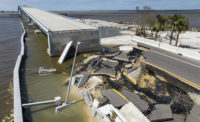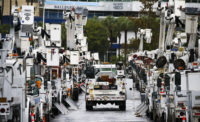Disaster Response
Hurricane Ian: Florida Expedites Road Work as Damage Comes Into Focus

The bridge leading from Fort Myers to Pine Island, Fla., is heavily damaged in the aftermath of Hurricane Ian, Saturday, Oct. 1, 2022. Gov. Ron DeSantis has expedited emergency, temporary repairs, set to be complete Oct. 8 to provide access to Pine Island.
AP Photo/Gerald Herbert
Hurricane Ian’s devastation is coming into view days after the storm decimated southwest Florida. Work is underway to rebuild much of the state’s electrical, transportation and other infrastructure, with certain emergency road repairs expedited and restoration of power prioritized after the storm's devastation left millions in the dark and washed out roadways serving as the only access to barrier islands such as Sanibel Island and Pine Island.
State emergency officials reported more than 1,600 completed rescues as of 7 a.m. Oct. 2, with Florida National Guard missions ongoing in 14 counties, supporting 152 active missions with 5,200 personnel. The U.S. Coast Guard and U.S. National Guard were continuing helicopter landings on barrier islands, and the Associated Press reported at least 68 deaths from the storm: 61 in Florida, four in North Carolina and three in Cuba as of Oct. 3.
Florida Fast-tracks Road Fix
Gov. Ron DeSantis (R) directed the Florida Dept. of Transportation (FDOT) to expedite emergency repairs to roads and bridges providing access to Pine Island in Lee County with the goal of having the island accessible by Oct. 8.
FDOT is mobilizing equipment, materials and manpower to the area to construct a temporary road to reconnect access from the mainland to island, after which a permanent replacement will be constructed.
As of Oct. 2, the agency had completed more than 2,500 bridge inspections and under-construction road projects were cleared to resume work, according to a statement, while many roads remain closed across southwestern Florida.
The causeway to Sanibel Island remains impassable as Florida and Coast Guard crews perform rescue operations and deliver emergency supplies, support services and personnel to the island, according to a release Sept. 30 from DeSantis’ office. In a news briefing the day before, he said the causeway will require structural rebuilds.
Past Resilience Efforts Pay Off
Hurricane Ian encountered a Florida grid bolstered by years of work begun after Hurricane Wilma in 2005, when utility Florida Power & Light embarked on a $3-billion effort to strengthen its power grid, hardening feeder lines from substations to distribution transformers and strengthening utility poles to at least 90% concrete and steel.
The utility reported Oct. 3 that no significant structural damage occurred to generating facilities and no transmission structures were lost during Hurricane Ian. Neighborhood underground lines in the hardest-hit areas performed five times better than overhead lines, it said.
Florida Power & Light said Oct. 3 that it has restored power to about 1.8 million of 2.1 million customers, and is expecting to restore power by Oct. 7 to 95% of about 369,000 customers still in the dark.
Duke Energy, which supplies power to almost 2 million customers in Florida, said that as of Oct. 2, power had been restored to more than 930,000 customers with 77,000 still without.
Power outages in Florida peaked Sept. 29 at 2.7 million customers, according to the Edison Electric Institute, which reports more than 44,000 workers from at least 33 states were working around the clock to complete damage assessments and restore power.
The storm crossed Florida into the Atlantic before making a second landfall in the Carolinas and Virginia, where approximately 370,000 were without power Oct. 1. Duke Energy expeced to have power restored to most customers by Oct. 3.
Wrapping up a 15-year, $1.6-billion project to rehabilitate the Herbert Hoover Dike around Lake Okeechobee, U.S. Army Corps of Engineers engineers that inspected it found no areas of concern, spokesperson Jim Yocum said, adding that the Corps is confident it was in the best position it had ever been going into a storm.
“We expect heavy inflows from the northern basins over the next three weeks to a month,” he said. “But because the lake was lower than normal after an unusually dry period this rainy season, our water managers believe we will be able to take the water from this storm without the need for imminent releases of water to the estuaries.”
The Corps dispatched seven inspection teams across Florida on Oct. 2, said spokesperson David Ruderman. Inspections are ongoing and will determine the need for further analysis and the potential pursuit of flood control and coastal emergencies interventions, which provide 100% federally funded emergency shore remediation and risk management operations, he said. The Corps in Jacksonville is "in the most preliminary stage possible in making such determinations,” Ruderman added.
Contractors Mobilize to Help
Steve Cona, president and CEO of the Florida Gulf Coast chapter of Associated Builders and Contractors, said hard-hit barrier islands have many older structures that were destroyed or damaged.
He said member companies are working to assist in the recovery efforts, sending resources and supplies and fielding calls mainly for continued cleanup supplies such as dumpsters and storage units.
“We’re trying to coordinate efforts to make sure we get the right people talking to each other,” he said. “Obviously, Florida has a bit of an older population and people are just trying to help get those roofs tarped up to where they’re not going to take on any water until they can take on proper repairs.”
Cona said he had not heard of any ongoing construction sites that were damaged, but a lot of critical infrastructure needs to be rebuilt before the damage assessment process can start in earnest.
He said state regulations allow licensed contractors from other states to work in Florida under state-licensed contractors. “The more people we can get here, the quicker we’re going to be able to get stuff rebuilt,” Cona said.




